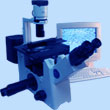
Methods of Investigation
for FP7 partners
and coordinators
|
|||
| Home | |||
| Cytotechnology Group | |||
| Staff | |||
| Methods | |||
| Projects | |||
| Research Results | |||
| Patents | |||
| Image Gallery | |||
| Cooperation | |||
| Contact Us | |||
Magnetophoretic Behaviour of a Pancreatic Cell Suspension |
|
International Conference on Intensifying Proceedings of Biomaterial Processings. Sinaia, Romania (August 20-23, 2007) MAGNETOPHORETIC BEHAVIOUR OF A PANCREATIC CELL SUSPENSION Medical technologies of cell transplantation depend on the progress of cell separation. The existing procedures are based on the difference of cells in bulk density and in receptor markers. The latter has found application in immunomagnetic separation of cells which is based on binding the cells to be separated to magnetic nanoparticle. This method is potentially damaging, costly, and it involves essential loss of specialized cells and a drop in viability of a sowing material. An example is the process of an enzymatic disintegration of specialized tissues for deriving functional cells, in particular, pancreatic cells. Due to impossibility to separate the completely disintegrated fraction from the reactor it is necessary, to preserve its functionality, to terminate the process of fermentation at early stages, thus losing considerable portion of functional cells in clusters with tissues and fibroblasts. The ultimate goal of our studies is to increase the efficiency and purity of differentiation of beta cells from cell suspensions intended for cultivation and transplantation, making use of the difference of cell magnetic properties. The method of direct magnetic separation has principal advantages because it does not affect cells in any dangerous way. The present state-of-the-art concerning the direct magnetic separation of cells is rather superficial. The red blood cell represents a single instance which has aroused a noticeable interest. We present the results of a computer-aided video recording of magnetophoretic motion (following technique decribed here) of a suspension of partially separated fetal rabbit pancreas (collagenase II, 0.5 mg/ml - 5 min), settling in a liquid (cultural medium RPMI1640 with 10% fetal bovine serum) near a thin (0.5 mm) vertical magnetic rod under the influence of the uniform magnetic field with induction of 0.8 T. The suspension included pieces of debris, single cells and islets composed of more than 6-8 cells. All these objects demonstrate contrasting magnetophoretic behavior. While single cells are practically insensitive to magnetic field, the pieces of debris (8-20 µm ID) are essentially paramagnetic (with respect to the liquid carrier) and move towards the magnetic rod with velocity of ~ 30 µm/s at a distance of 300 µm from the rod, and of ~ 100 µm/s at 100 µm. At the same time, the islets are repelled from the rod (diamagnetic), their magnetophoretic velocity being only one tenth of the debris velocity. The obtained results are analyzed on the basis of macroscopic theory which allows restoring magnetic properties of investigated cellular objects. We believe that our observations support the idea that direct magnetophoresis can be a promising trend in cell science and technology. |
| COOPERATION NEWS | ||
FP7 Programme involves subjects
|
||
| CURRENT RESEARCH | ||
|
||
| 2005-2007 © LBMI |


